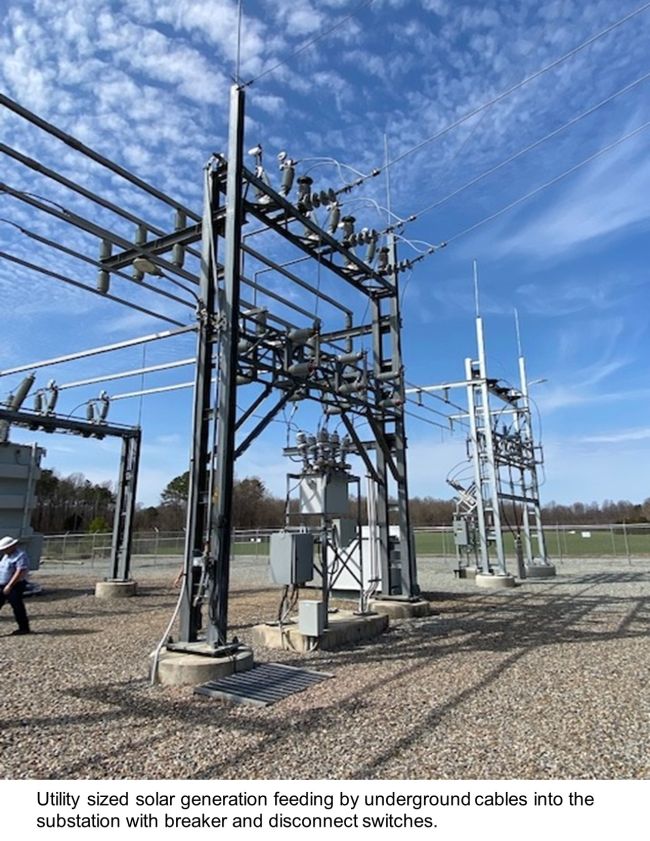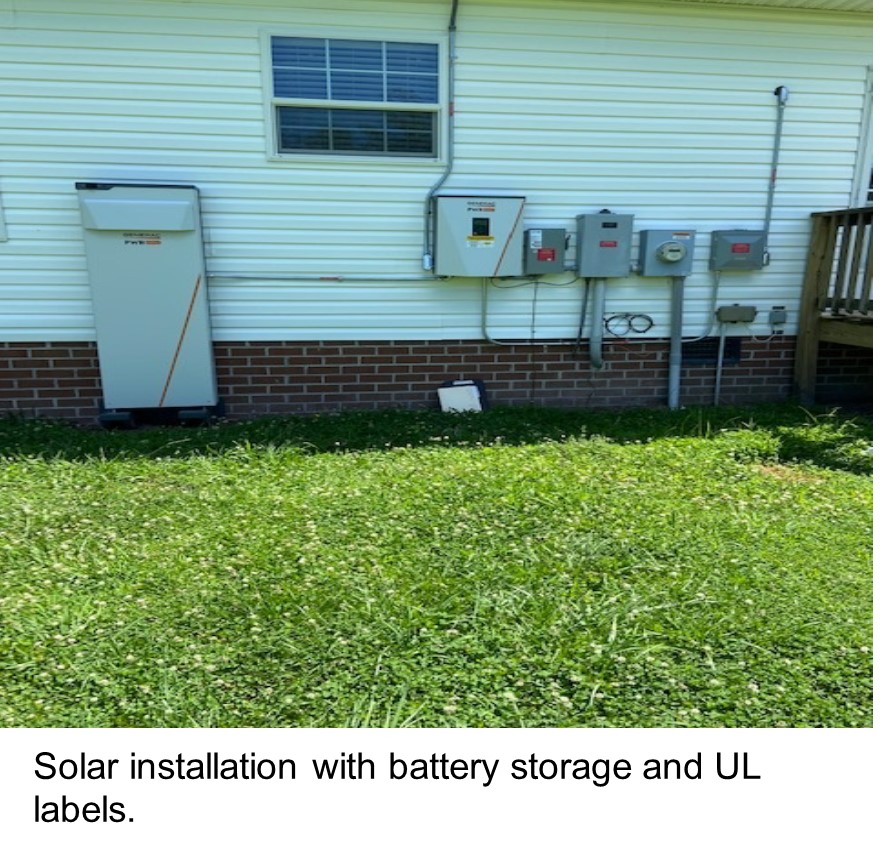
Solar Backfeed Safety on Distribution and Secondary Circuits
Lineworkers must use the four lifesaving rules for zero contact to protect themselves.
Editor’s Note: This timely article specifically addresses the contemporary issue of green-energy backfeed endangering power-line workers. Unlike engine-powered backup generators, green energy makes no telltale noise to alert workers to its presence and possible hazards. Incident Prevention encourages all employers to assess the risks related to backup energy sources and adopt effective storm-work hazard analysis, isolation and other protective procedures for worker safety.
It is night and you are working storm trouble on a single-phase line. The line fuse is blown, and you find wire down. Then you notice that the customer beyond the broken section of wire still has power. Is there a two-way feed on this phase? Did you identify the correct opened line fuse?
No, there is no two-way feed, and yes, you identified the correct opened line fuse feeding the downed phase wire. This trouble call is different from traditional radial feed or one-way electric power flow. This call includes solar panels in the customer’s backyard that are attached to battery storage on the side of their house. The battery storage supplied by solar generation is flowing through a non-UL-labeled inverter that is connected directly to the customer’s breaker panel. The 200-amp main disconnect in the breaker panel is closed, and power is backfeeding through the customer’s meter, through the secondary windings of the transformer and out onto the downed primary wire.
In an effort to help keep lineworkers safe and knowledgeable, the remainder of this article will cover information on solar distributed generation and how to protect yourself from backfeed.
Some History
In the past, power corporations owned their generation, transmission and distribution lines and equipment. Traditionally, large power plants produced the power that flowed over transmission networks in the megawatt or gigawatt range to substations that reduced the high voltage of the transmission lines to distribution voltages. The distribution power flowed to the consumer in one direction.
However, deregulation separated the traditional generation, transmission and distribution ownership to promote competition. In the 1990s, distributed generation and clean, renewable energy – like solar – became increasingly cost effective. Consumers of electric power could own and install distribution generators and renewable energy technologies on their own property. This upset the traditional electric power infrastructure as some consumers of electric power, even homeowners, became generators of that power. Additionally, this upset the distribution grids by having two-way power flows and significantly reduced one-way power flow that was not traditionally planned for.
Two-way electric power flows are acceptable when the power system is working properly and distributed generation, like solar, is passing through utility-approved switches and meters. Such flow is not acceptable when the power system circuits become de-energized by a storm and the two-way electric power flow then becomes backfeed on downed lines. In addition, it is not acceptable for customers to install distributed generation without transfer or manual load-break switches, thereby allowing the distributed generation to become backfeed on the power system’s downed lines.
Preventing Unintentional Backfeed
By definition, backfeed is power flowing opposite of the usual direction. It can be intentional or unintentional. Through switching, a utility can create intentional backfeed by reversing the power flow to restore power to customers during outages. However, unintentional backfeed can come from distributed generation sources, such as solar, battery storage and generators. Lineworkers must be aware of and always protect themselves from unintentional backfeed.
To prevent unintentional backfeed, there are correct ways to install solar panels and related equipment that are tied to the grid. All grid-tied equipment, like inverters, should have the UL label. Standard UL 1741 details the interconnection equipment, the tests that must be conducted, construction, and protection against risks and injury to people. An inverter that is grid-tied with the UL label, for example, should shut off if the power grid goes down or if the AC frequency of the power grid changes. This type of inverter prevents the customer’s house from becoming an island.
“A Guidebook on Grid Interconnection and Islanded Operation of Mini-Grid Power Systems Up to 200 kW” describes islanding as a “condition in which a portion of the grid becomes temporarily isolated from the main grid but remains energized by its own distributed generation resource(s). Islanding may occur accidentally or deliberately. Traditionally, islanding has been seen by utilities as an undesirable condition due to concerns about safety, equipment protection, and system control” (see www.osti.gov/biblio/1171616).
IEEE 1547 describes intentional and unintentional islanding. An intentional island is a planned electrical island that is capable of being energized by a utility’s electric power system and has one or more distributed energy resources and load. The intentional island can disconnect from the utility’s electric power system and be in parallel with it. An unintentional island is an unplanned island that is capable of being energized by the electric power system and has a distributed energy resource and load. The unintentional island is a concern for lineworkers because the distributed generation continues to operate when the utility’s power grid is down due to fallen lines. Both intentional and unintentional islanding rely on inverters and switches to isolate the distributed generation from the grid. Furthermore, there are customers who have solar distributed generation that is tied to the electric power system that can become an island when the power goes out or the frequency changes. The disconnect switches on these customers’ houses or facilities must be checked open, locked open and tagged on circuits with downed lines. If the disconnect switch cannot be opened or verified, the meter can be pulled and blanked out.

Four Rules for Zero Contact
Let’s imagine for a moment that a do-it-yourself customer installed his solar panels and equipment for off-grid use, such as when the power goes out. His installation was not inspected by an electrical inspector nor approved by the utility. While working on downed power lines, lineworkers must protect themselves from this type of incorrect solar installation just as they would from any distributed generation (e.g., an incorrect generator installation).
Lineworkers can protect themselves by always adhering to the four lifesaving rules for zero contact. The National Rural Electric Cooperative Association and the Federated Rural Electric Insurance Exchange establish those rules in “Commitment to Zero Contacts: Implementation Guide for Field Personnel” (see www.cooperative.com/programs-services/safety-resap/commitment-to-zero/Documents/committozero_guide_fieldpersonnel.pdf). They are as follows:
- Use rubber gloves and sleeves.
- Apply proper insulating material or coverup.
- Use proper clearance procedures.
- Test lines de-energized and apply personal grounds.
These rules apply not only to traditional power flow but also to distributed generation backfeed, like solar. Lineworkers should always wear rubber gloves and sleeves when working ungrounded lines. Remember that power lines are considered energized until they are grounded. In addition to rubber gloves and sleeves, proper insulating material or coverup is necessary to protect lineworkers. To de-energize lines and equipment, use proper clearance procedures, test the lines de-energized and apply personal grounds.
When using proper clearance procedures that align with the OSHA rules, the person in charge of the crew shall request clearance on the line to be worked from operations or dispatch. If operations or dispatch does not exist, the person in charge of the crew takes clearance on the downed lines. Through operations or by the employee in charge, all sources of electric energy are to be de-energized. In 1910.269(m)(3)(ii), OSHA states that the “employer shall ensure that all switches, disconnectors, jumpers, taps, and other means through which known sources of electric energy may be supplied to the particular lines and equipment to be deenergized are open.” Lineworkers shall render such means of energized sources inoperable, unless the design will not allow a lock, and then ensure that such means are tagged to indicate that lineworkers are at work. Solar distributed generation is a source of electrical energy that must be disconnected from the utility’s secondary or primary lines. This means the solar distributed generation disconnect must be opened, locked open and tagged to indicate lineworkers are at work.
It is recommended that customer houses with solar generation have manual load-break disconnect switches. The switch locations should be approved by the utility and easily accessible at any time of day or night. Load-break switches – when opened, locked open and tagged open – should prevent power from flowing to the electric power grid.
Additionally, utility-sized solar distribution generation should have reclosers or a breaker to break the load and disconnect switches for a visible opening. Utility-sized solar distribution generation may have automatic switches that open if the voltage or frequency changes. A lineworker should not trust their life to an automatic switch. Such switches must be opened, locked open and tagged to indicate employees are at work. In addition, solar distributed generation on secondary lines that are improperly installed should have the meters removed and blanked out to protect workers and the public.
De-Energizing and Grounding
After taking proper clearance, lineworkers should test lines de-energized to verify all voltage sources have been opened, including distributed generation sources. If all lines test de-energized through use of a voltage tester, then apply bracket grounding per IEEE 1048-2016, “Guide for Protective Grounding of Power Lines.” OSHA refers to IEEE 1048 in 1910.269(n), “Grounding for the protection of employees.” Bracket grounding means applying grounds on both sides of the downed wire. Apply the bracket grounds in a bolted fault configuration on two-phase and three-phase lines by connecting a ground from the neutral to the phase closest to the lineworker. Then, connect a ground from the closest phase to the middle phase, and another ground from the middle phase to the farthest phase from the lineworker.
A bolted fault configuration connects the phases and neutral together to provide maximum fault current on the circuit to quickly open breakers in the substation. The grounds being applied in this configuration should be capable of handling the fault current at that location. Obtainable fault currents can be determined by an arc flash study of the utility’s circuits. If grounds are applied, workers on the ground should wear rubber gloves when handling downed wire. Rubber gloves worn by workers on the ground will protect them from touch potential caused by backfeed.
At the pole where the wire is down and is to be pulled to sag, equipotential grounds per OSHA 1910.269(n)(3) and IEEE 1048 shall be used to protect workers. Paragraph 1910.269(n)(3), “Equipotential zone,” states the following: “Temporary protective grounds shall be placed at such locations and arranged in such a manner that the employer can demonstrate will prevent each employee from being exposed to hazardous differences in electric potential.” Equipotential grounds are installed from the bracket that attaches around the pole below the lineworker’s feet and then connected to the neutral. Another ground is connected from the bracket to the phase closest to the lineworker. The next ground is attached from the phase closest to the lineworker to the middle phase. Another ground is attached from the middle phase and connected to the farthest phase from the lineworker. Equipotential grounding provides protection for the worker at the top of the pole and in the bucket by making the top of the pole the same potential as the neutral and phase wires. Equipotential grounding also provides a bolted fault configuration to open sectionalizing devices quickly.
Conclusion
Traditional radial electric power flow or power flow in one direction is no longer. More and more solar distributed generation is being constructed. Lineworkers must use the four lifesaving rules for zero contact to protect themselves. As a final reminder, those rules are to use rubber gloves and sleeves, apply proper insulating material or coverup, use proper clearance procedures, and test lines de-energized and apply personal grounds.
About the Author: Jerone Mabe is manager of technical services for the Virginia, Maryland & Delaware Association of Electric Cooperatives. Reach him at jmabe@vmdaec.com.

